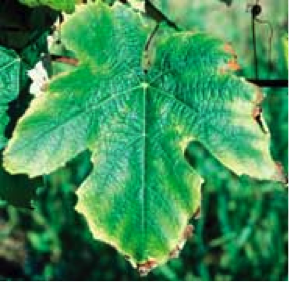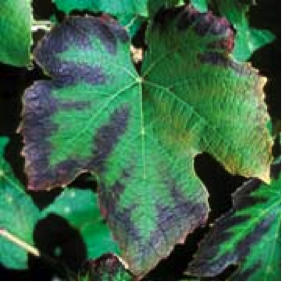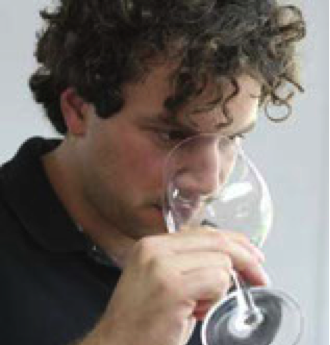Heavy Early-Season Rains Create Potassium Deficiency
Potassium is important for grapevines to function and is one of the most frequent nutritional deficiencies of vines. A grapevine with inadequate potassium produces poor, unevenly ripened fruit and reduced yields. Severe deficiency results in defoliation. Leaves in the mid- to basal portions of shoots are affected. Clusters of deficient vines tend to be small with a few unevenly ripened berries. Shatter of berries occurs in extreme cases. The relationship between another reported symptom, ‘black leaf,” and potassium deficiency is in doubt. Leaf petiole testing can reliably confirm potassium deficiency. (Source: Michigan State University.)
The heavy and persistent rains from April to June across much of the cold climate grape belt have led to nutrient imbalances in the vines of some vineyards, with high levels of nitrogen uptake from wet soils reducing potassium and magnesium to throw nutrition out of balance.
That is the finding of tissue analysis from several vineyards, particularly those in parts of Iowa, says Larry Shafer, vice president, Agro-K Corporation in Minneapolis. Potassium deficiency produces poor, unevenly set and ripened fruit, reduces vine vigor, and reduces yields. As an essential part of chlorophyll, magnesium is crucial for photosynthesis, along with important roles in carbohydrate metabolism and protein synthesis.
‘All that rain soaked the soil, which encourages nitrogen to come up in the vines,” Shafer says. ‘There is late vegetative growth and the vines get out of balance. We recommend starting KDL® at first color because of the fruit load, nutrient imbalance, and the season likely being shorter to get the grapes to finish and at the required brix for harvesting. Then there’s always the worry that we could have another frost in September.”
Just about everyone in the upper Midwest saw a long, unusual, and in many cases very wet spring. Even many growers who did not have as many saturating rains say their vines are two to three weeks behind where they normally would be. With the more seasonal heat that began in mid-July, vineyards will catch up some, though some may still be behind normal development.
‘Foliar feeding is one way you can make up some of this by not leaving the crop to its own discretion and instead stimulating and re-stimulating the vines, pushing them on and keeping them going,” says Shafer. University of Virginia Extension research has demonstrated that foliar feeding is six to 30 times more efficient than applying nutrition amendments to the soil, and in mid-season every day is important.
At mid-July John Burns was in the process of an extensive program to rebalance the nutrition in his cultivars at Barrel Head Winery near Dubuque, Iowa. Iowa State University weather data shows that from April 1 to May 30, Dubuque had 16.67 inches of rain. Average is about 7 inches.
‘We sample leaves from each variety to find out how the nutrients are doing, and the lab results showed the vines were high in nitrogen,” says Burns. ‘We asked Larry for a recommendation and the materials arrived the next day so we could get them on the vines right away. About the first of July we sprayed a gallon of 3-18-18 [Agrobest®] with a quart of Sysstemâ„¢-CAL and two quarts of KDL® [aka Potassium Dextro-Lac®].
‘The next week we saw a big growth spurt, which will provide more foliage for the follow-up KDL sprays. We’ll use KDL again when we see first color. That spray will be a quart of Sysstem-CAL and two quarts of KDL. It’s been great so far, and we’ve already seen a 2% sugars increase. Plants seem to really like it. There is a fast sugar climb when we get KDL into the plants. We don’t want to wait until the threat of first frost to give the vines the nutrients they need. This way we get ahead in the game by getting the sugar balanced before we get cold weather.”
Shafer says starting the additional KDL at first color or about 20% to 30% color in the fruit will allow the grower to tweak the balance. If the heat persists and the weather cooperates, the berries may sugar well.
‘If they are not coming up to between 19 and 20 brix we may hit them with another quart of Sysstem-Cal and as much as a gallon of KDL,” says Shafer. ‘Adding calcium helps with overall vine health and also seems to give a rapid uptake of potassium and mobilizes it throughout the plant. The 3-18-18 was recommended because tissue tests showed the vines of all three cultivars were low in phosphorus. An initial spray to correct that might be two quarts of 3-18-18 and two quarts of KDL.
‘At one time our thinking was that phosphorus is important for flower and fruiting, but once you get the berries on, any phosphorus is going to be for next year’s bud return and crop,” Shafer notes. ‘But in recent years our experience has been that where growers had extremely low phosphorus, the grapes failed to finish. There were fewer seeds in the fruit, and it was harder to get the grapes to have the uniform color and get the brix the growers wanted. Our thinking now is that phosphorus may not be the main engine, but it is an important ingredient for getting the final fruit up to where it should be.”
Burns agrees that managing plant nutrition with foliar sprays is the most efficient and timely way to make adjustments.
‘Iowa really got drenched this year,” says Burns. ‘You can put nutrients on the soil, but this year most of that would have been washed away. Foliar feeding is the quickest way to get nutrients into the plant. We have a 50 gallon sprayer, so we can foliar feed 1,000 plants efficiently and correctly. No screwing around or running equipment through there.
‘Another beauty of it is we have Japanese beetles, and Larry Shafer told us we could put some Sevin® right in with it, so we accomplished two things with one shot: feed the plants and keep the bugs off. Now the vines are growing so well we may be concerned about downy mildew and powdery mildew, but by giving the plants the foliar feeding, we hope they will be able to help themselves deal with the mildew issues if they arise.”
Shafer says keeping grape vines in nutritive balance in the Midwest is always a struggle.
‘Midwest heavy soils are wonderful for corn, soybeans and other crops, but for grapes this is a soil very rich in organic matter, and the result can be excessive vegetative growth. So growers have to ‘hedge’ or prune back excessive growth to manage the canopy. In the Midwest you can get a run of vegetative growth, and you’re always trying to bring nutrition back into balance. It’s best to start foliar potassium right after fruit set. Normally growers put down potash in the soil in the fall, but during the growing season if there is a heavy fruit load, unusual weather, or other stresses, the vines don’t get enough potassium. And because Midwest soils are full of organic nitrogen, the vines go full steam and the grower is always trying to catch up the potassium.
Nutritive balance is a management tool that enables grape growers to produce fine wines for themselves, or contract to provide grapes for others who produce high-quality wine. It means tailoring dynamic nutritional programs to each vineyard and changing the sprays during the season based on tissue analysis. Samples are best taken at two important times: post-set and pre-harvest. Additional tissue samples at pre-bloom and pre-veraison can be crucial when it is obvious that nutrient balance has been compromised as happened on the vines at Barrel Head and elsewhere in Iowa and parts of neighboring states.
‘Nutrient balance across the board is so important to make quality fruit,” says Shafer. ‘You can get the nutrient balance out of whack sometimes, and the vineyard will still make grapes. But, they won’t be grapes of superior quality for high-quality wine. That’s why balance is so important. You aren’t just looking for fruit to hang on there and sell. You want to turn those grapes into high-quality wine that you’ll be proud to display or enter into wine contests. If that’s the goal, you had better have everything up to snuff in terms of nutrients and then keep them in balance.”
Burns notes that the wines from grapes that he says KDL saved from the late frost in 2012 won three international silver medals: Two for Methode Champenoise and one for a Concord, ‘and they were only 7 months old.”
Leaf symptoms may begin in mid-June. Leaf margins turn yellow (left) and progress so that leaf margins become brown (right) and the tissue around the veins blackens. Photos: T. Zabadal
Potassium is important for grapevines to function and is one of the most frequent nutritional deficiencies of vines. A grapevine with inadequate potassium produces poor, unevenly ripened fruit and reduced yields. Severe deficiency results in defoliation. Leaves in the mid- to basal portions of shoots are affected. Clusters of deficient vines tend to be small with a few unevenly ripened berries. Shatter of berries occurs in extreme cases. The relationship between another reported symptom, ‘black leaf,” and potassium deficiency is in doubt. Leaf petiole testing can reliably confirm potassium deficiency.
Fro more information see: “Potassium Deficiency” by Tom Zabadal, Michigan State University Horticulture at http://www.grapes.msu.edu/potassium.htm
This article was produced, written and contributed by the Agro-K Corporation in Minneapolis.




